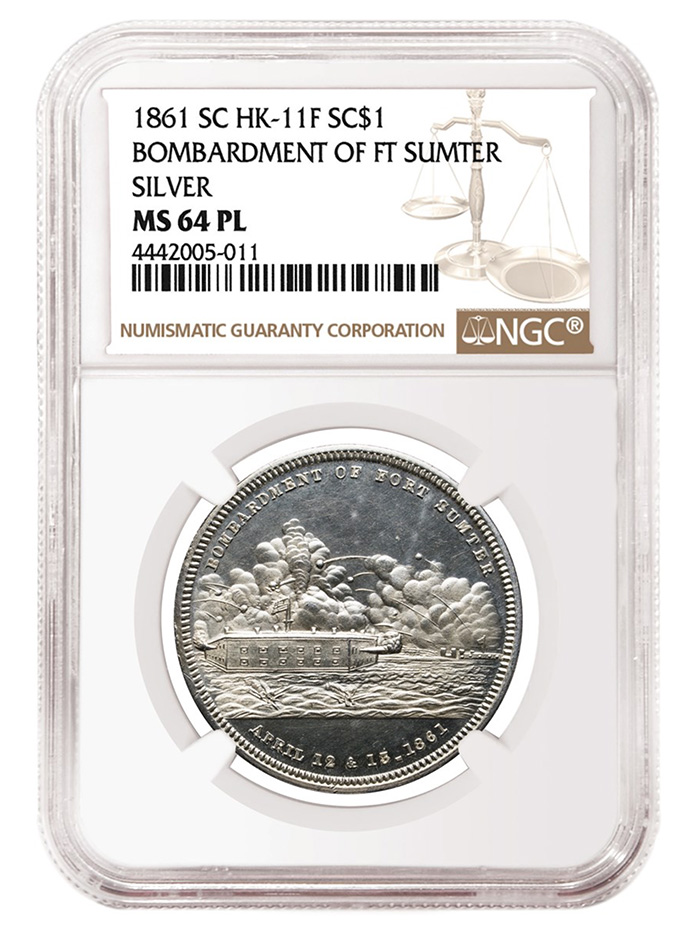NGC has identified a new silver variety of the Fort Sumter Medal as HK-11f
A new metal type for the renowned “Bombardment of Fort Sumter Dollar” was just identified by NGC’s tokens and medals team. This variety, found in silver, graded NGC MS 64, Prooflike. The piece is largely untoned, with very clean surfaces. NGC conducted both a metallurgic analysis and a specific gravity test to confirm its solid silver content, and that it was not a silver-plated copper specimen.
The second edition of Hibler & Kappen’s So-Called Dollar book lists this medal as HK-11, 11b, and 11c — as white metal, brass and copper, respectively. Each of these have a rarity listed at R-7 (meaning an estimated 11-20 known) in each metal type, though they are more common than the authors originally suggest. For instance, NGC has certified about a dozen examples in white metal and over 20 examples in copper. The original book only listed this piece in white metal. The medal is, nonetheless, still very rare in all metal types, and highly sought by collectors.

As this new silver variety is unlisted, NGC has elected to identify it as HK-11f. It is likely that a few others exist in silver, and are only waiting to be brought to light. At auction, prices for these medals can vary drastically, selling from as low as $700, to upwards of $3,000, as in the case of the copper example from the Rev. Dr. James G.K. McClure Collection. Silver is often the far more desirable metal type for tokens and medals, and this specimen could demand an even sharper premium in the right venue.
The firing upon Fort Sumter by Confederate forces under Brigadier General P.G.T. Beauregard marked the beginning of the American Civil War. The spotlight was upon US Army Major Robert Anderson, who led a small force of loyal troops from Fort Moultrie to the much stronger and more strategic position at Fort Sumter. Southern leaders were outraged at their “betrayal”, but their stance was celebrated in the North. As the medal highlights, the Union troops were severely outnumbered and outgunned. The fort was low on ammunition, and they had no fuses for exploding shells, so only solid shot could be used.

At 4:30 a.m., April 12, 1861, 43 Confederate guns and mortars began firing upon the fort in a counterclockwise sequence, and continued for 34 hours straight. Major Anderson wisely kept his men out of harm’s way by not manning guns on the top tier of the fort and other vulnerable areas. Exploding shells repeatedly landed inside the fort, and the Confederates heated other artillery rounds until they were glowing red hot, and targeted the fort’s wooden buildings. Before long, most of the buildings were in flames. During the bombardment, a shell struck the fort’s enormous flagpole, and the colors fell to the ground; but Norman J. Hall, a lieutenant, bravely exposed himself to enemy fire to put the flag back up. In doing so, his eyebrows were permanently singed off.
By April 13, the fort was almost entirely depleted of ammunition, and the condition of Anderson’s men was becoming dire. Also, the Union ships outside the harbor were unable to approach to help. With no other options, Anderson agreed to evacuate the fort. They had sustained about 3,000 shells along with raging fires inside the fort without losing a single man.
After his heroic actions, Anderson was promoted to brigadier general. He retained the fort’s 33-star flag, and it became a symbol at rallies in the North for nationalism and rejection of secessionism. At the war’s end in 1865, Major Anderson returned to Fort Sumter to raise the flag he had lowered four years earlier.
The Bombardment of Fort Sumter Dollar was likely struck soon after the event, as the Union capitalized on the heroics of these men to encourage enlistment. Unfortunately, the origin of the piece has been elusive to researchers. Dewitt lists this piece as being muled with a McClellan campaign medal, the dies for which were made by George Hampden Lovett of New York in 1864.





I OWNED THE ONE AND ONLY NGC GRADED HK-11E BOMBARDMENT OF FT. SUMTER, WITH THE 2ND REVERSE DIE WITH THE TYPE TWO EAGLE REVERSE “ONE FLAG AND ONE UNION” “NOW AND FOREVER”. THIS WAS A VERY EXCITING MEDAL TO COME ACROSS, BEING THE ONLY ONE GRADED, AND AS FAR AS I KNOW THE ONLY ONE KNOWN OF THIS TYPE GRADED OR RAW. I HAVE SINCE SOLD THIS MEDAL TO A VERY HIGH END COLLECTOR OF SO-CALLED DOLLARS.
I now own this HK-11F so-called dollar medal. I also now own another HK-11E example graded MS 65 RB that is the top pop of only two graded by NGC of the type. I am very proud and fortunate to be able to obtain these two extremely important medals.